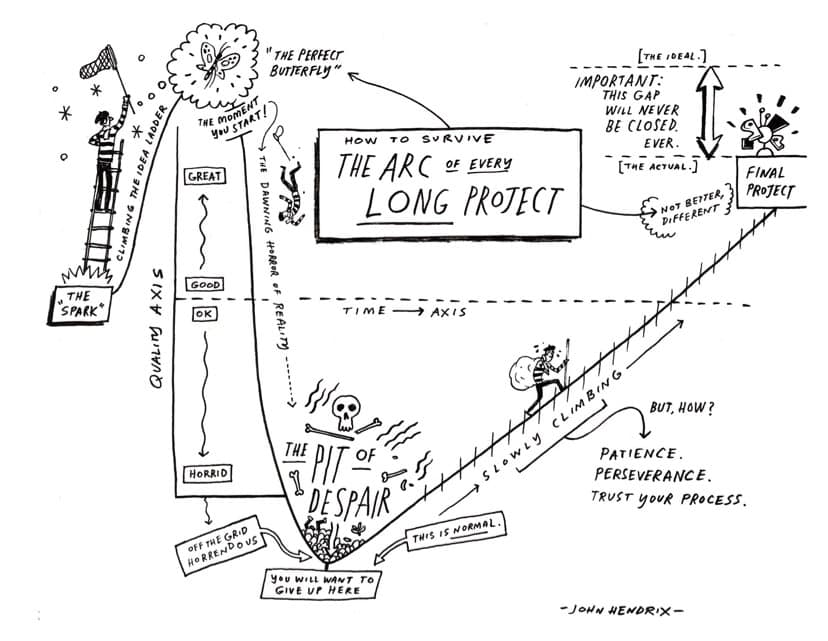Artist and graphic novelist John Hendrix posted this image of what it feels like to do a big creative project (you can click to see a bigger version):

That looks about right to me. You start with a big idea that you find exciting—otherwise, you wouldn’t start at all. But creative work isn’t really about having big, exciting ideas. That’s the easy part. The hard part is giving the big idea a form so that it can exist outside your head and heart and do its work in the heads and hearts of other people.
When you start doing creative work, it’s easy to get discouraged. As John’s picture has it, you’re liable to fall off the creative high and into the Pit of Despair the moment you start.
The Quality Axis—from Great to Good to OK to Horrid to Horrendous—refers, I think, to the artist/writer’s perception of the work’s quality rather than its actual quality. As you can see from the diagram, you can be in the Pit of Despair before you’ve done any work to speak of. That’s when you’re most likely to quit. But if you trust the process and just do the work, you can begin to climb out of the Pit of Despair.
Success builds on success. I’m defining “success” very loosely here. Really, I’m just talking about getting words on the page. Find one square inch of your story or essay or book, and write it—badly, if you have to. Once you’ve done that, write another square inch. (I’m borrowing here from Anne Lamott’s Bird by Bird, one of the best books on writing there has ever been.)
Are there problems ahead that you don’t know how you’re going to solve? Of course there are. So don’t solve them. I promise there is a problem you can solve right now, even if it’s just the problem of how to depict your main character’s posture during a work meeting, or how to define a key term in an argument you want to make. Just take one step up the slope leading out of the Pit of Despair and trust that you’ll be able to take Steps 2 through 99,999 when the time comes. Some of those steps, no doubt, will involve coming back and re-solving problems that you solved already, but now you’re able to see how to sold them better. You learn to do the work by doing the work. That’s what it means to “trust the process.”
As John’s picture shows, there will always be a gap between the actual and the ideal. That’s a truth that the artist in the postlapsarian world has to learn to live with. But, as I discussed last week, I find that I don’t usually have any access to my best ideas until long after I’ve started writing. I can go back to anything I’ve ever written and see how it falls short of the ideal. But for a good many of those stories and essays, my understanding grew in the writing process such that the end product turned out better than my original sense of the piece’s ideal form, even if it fell short of my new, improved ideal.
John Hendrix’s Pit of Despair made me think of something Patrick Curry wrote in Defending Middle-Earth:
Despair is for people who know, beyond any doubt, what the future is going to bring. Nobody is in that position. So despair is not only a kind of sin, theologically, but also a simple mistake, because nobody actually knows. In that sense there is always hope.
So, my writing friends, do not despair. Trust the process to see you out of the pit.








